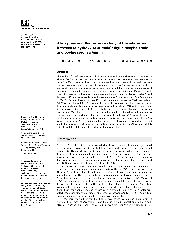摘要
The binding of Schiff base selenide, (2-hydroxy-benzimido)ethyl-n-hexylselenide, to bovine serum albumin (BSA) was studied using fluorescence spectroscopy. The measurement was performed in Tris-HCl buffer aqueous medium at pH 7.4. Stern-Volmer graphs were plotted and quenching constants were estimated. The quenching constant at 303 K was (1.639 +/- 0.046) x 10(13) Lmol(-1) s(-1). Decreased quenching was observed as temperature increased, but at the temperature range of 303-313 K, the association of Schiff base selenide to BSA was not significantly different. The static quenching presented in the system of Schiff base selenide and BSA. A complex was possibly formed between Schiff base selenide and BSA, which was responsible for the quenching of the fluorescence of BSA. This fact was also confirmed by differences in the absorption spectra of BSA before and after Schiff base selenide addition. The hydrophobic interaction was found to play a main role in the binding according to the thermodynamic parameters, enthalpy change (DeltaH) and entropy change (DeltaS) of reaction. Schiff base selenide most likely binds to the hydrophobic pockets within sub domain IIA of BSA, which can be proved by competition experiments for sodium dodecyl sulfate. By constant-wavelength synchronous fluorescence spectra, the influence of (2-hydroxy-benzimido)ethyl-n-hexylselenide on the surrounding environment of tyrosine and tryptophan residues in BSA was also investigated. The red shift of the fluorescence peak of tryptophan residues indicated that the hydrophobic amino acid structure surrounding tryptophan residues in BSA collapsed slightly after the addition of (2-hydroxy-benzimido)ethyl-n-hexylselenide.
